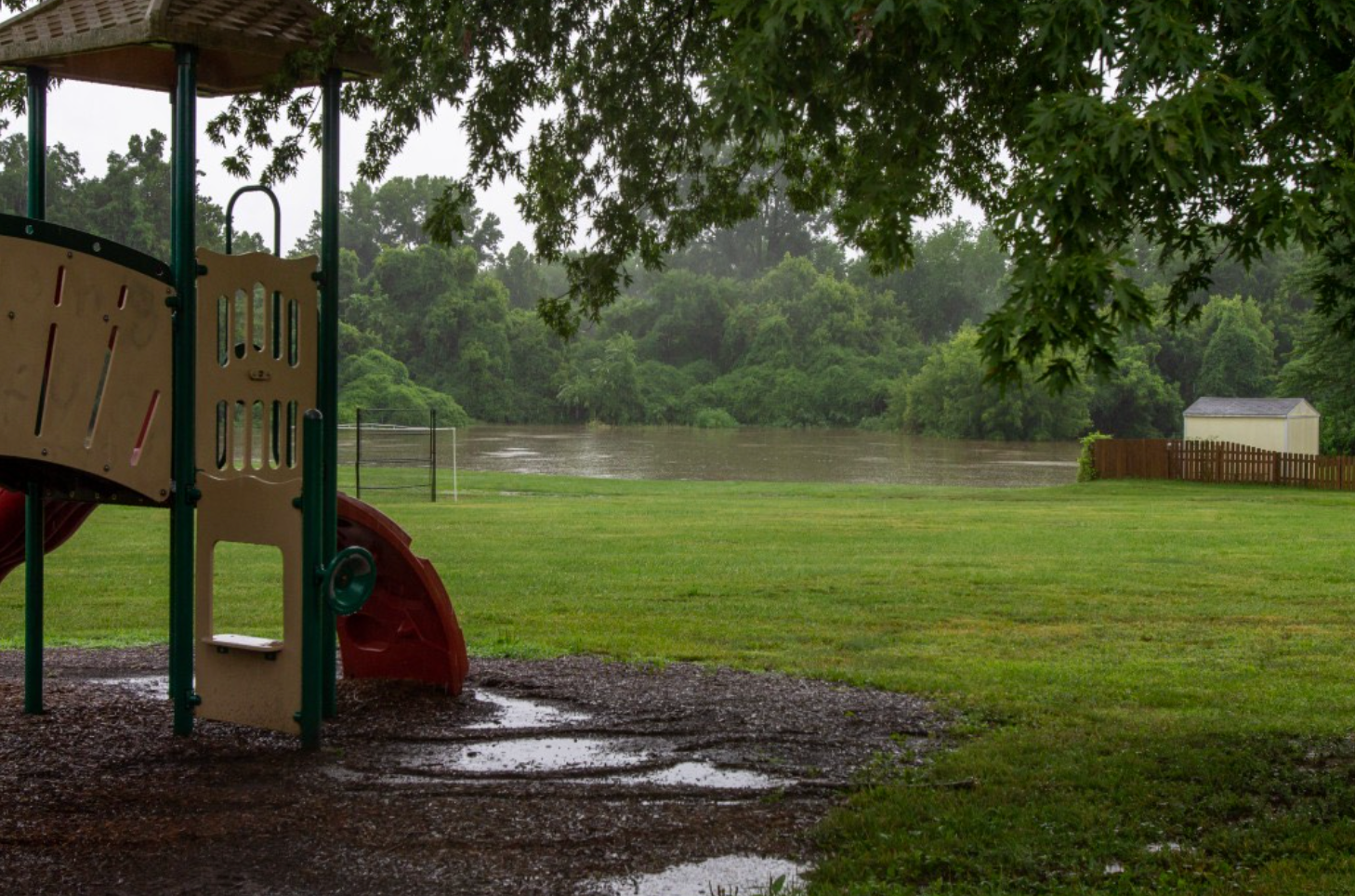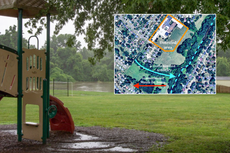Missouri elementary school to be closed after radioactive waste discovered
A number of residents broke down as they spoke about the high rates of cancer and other illnesses prevalent in the community
An elementary school in Missouri riddled with radioactive contamination is to be closed, it was announced at an emotional school board meeting on Tuesday night.
A new independent environmental study, made public last week, found significant radioactive material throughout Jana Elementary School in Florissant.
The contamination was discovered in the library, cafeteria, basketball courts and kindergarten playground of the school, located in the northern suburb of St. Louis, and where the majority of the 400 students are Black.
The board of the Hazelwood School District, where the elementary school is located, announced at a packed meeting on Tuesday that students would revert to virtual lessons on Monday. Redistricting options were being explored for next semester.
The school board members apologised to parents, and said that they were working with legal counsel to ensure “the necessary clean up of any and all hazardous waste”.
The meeting was extended due to the number of comments from members of the community, many who were highly emotional.
One man raised the contamination as one of environmental justice and urged the school board to look into the recently-passed Inflation Reduction Act which includes funding to specifically address toxic pollution which has long disproportionately impacted communities of color.
Some speakers thanked the school board for taking action while others demanded to know why the news of the radioactive material had not been communicated sooner.
Other parents and caregivers were frustated by the return to virtual lessons after children had spent months of the pandemic learning this way.
“We don’t blame you all for what happened but we do want to hear what’s going on,” said one mother, Patrice Strickland.
Kimberly Patterson, whose three grandchildren attend Jana Elementary, also said that there had been little communication about the radioactive contamination and that she had already started planning bloodwork and testing for them.
A number of residents broke down as they spoke about the high rates of cancer and other illnesses that they said are prevalent in the community.

Karen Nickel, who grew up in the area formed Just Moms STL, which has campaigned for the clean up of the nuclear waste. She spoke about her battle with autoimmune diseases and how her daughter was born with a mass on her ovary.
She thanked the school board for making the decision to remove the children from the school.
“No one protected me,” she said. “You guys are saving lives.”
Trisha Burns, who told the meeting that her child has rare cancer of the thymus warned that the toxic pollution could go on “for generations” and called for lifelong screening for all those who lived in the area.
Missouri State Representative Doug Clemens, who chairs a caucus to tackle legacy waste in the state, warned that children were most susceptible to the ionizing radiation pollution. He lambasted the federal Department of Energy, and also the Department of Defense, for “dragging their feet cleaning it up”.
The new report was conducted by environmental consultants Boston Chemical Data Corp. Based on dust samples gathered in August, the independent analysis found radioactive isotope lead-210, polonium, radium contamination, and other toxins, “far in excess” throughout the school.
The grim findings shocked but hardly surprised many local residents who have long warned about the impacts of the radioactive waste dumped in the open air at the nearby West Lake landfill half a century ago by the US Department of Energy.
The story traces back to the Second World War’s Manhattan Project, when the Department of Energy chose St Louis as the processing site for the uranium to make the first atomic bombs.
The nuclear waste was originally stored at the St Louis-Lambert International Airport but later moved and illegally dumped at the West Lake Landfill in Bridgeton in 1973.
Over the year, contaminants from the radioactive waste have seeped into Coldwater Creek which runs for nine miles through the area and flows into the Missouri River.
Jana Elementary is bordered on two sides by the creek, which regularly floods into school grounds and the wider community.
In July, record rainfall in the region triggered flash floods and led to Coldwater Creek submerging parts of the local communities.
The US Army Corps of Engineers, which oversees the cleanup of thousands of hazardous “Superfund” sites around the US, has been cleaning up the creek for more than 20 years. The Army Corps has conducted its own testing which found contamination at lower levels than the new, independent study.
“The Army Corps’ tests are incomplete and inadequate as no samples were collected from the school buildings themselves, nor were they collected from surface soils immediately surrounding the school buildings. It is not possible to assess the risk to students and employees of Jana Elementary because the Army Corps’ testing was limited to outdoor soil samples,” the new Boston Chemical Data Corp report reads.
“The Army Corps also failed to sample from areas nearest the actual occupied school buildings.”
Among the new findings is that lead-210 was found at 22 times the expected level in the kindergarten play area and at 12 times the expected level in soils next to the school’s basketball courts. Lead-210 is a neurotoxin linked to cancer and which has been known to cause brain damage and reduced cognitive capacity, especially in children, according to the Toxin Database.
The consultants’ report also discovered radioactively contaminated soil that was “many times above” levels deemed acceptable by federal government regulations.
Radium 266, a radioactive metal, was found at twice the safe level in the kindergarten play area, the report said. Contaminated samples were also found in the school library, classrooms, cafeteria fan, boiler room and the heating, ventilation, and air conditioning (HVAC) system.
“Most importantly, the radioactive wastes at the Jana School and other North St Louis County sites are rich in thorium-230, a radioactive isotope that emits highly damaging alpha radiation,” the report stated.
A Missouri Department of Health analysis of cancer cases in the eight zip code areas around Coldwater Creek, between 1996- 2011, found elevated numbers.
This included a “significant higher than expected” number of incident cases of brain and other nervous system cancers among children age 17 or younger in zip code 63043 during that period.
In a statement to The Independent, Phil Moser, program manager with the US Army Corps of Engineers, St Louis District Formerly Utilized Sites Remedial Action Program (FUSRAP), said that his team “is committed to our mission of executing the Record of Decision (ROD) for The North St. Louis County Sites”.
The statement continued: “Our team will evaluate the Boston Chemical Data Corp. report and methods used to create these results. The Boston Chemical Data Corp. report is not consistent with our accepted evaluation techniques and must be thoroughly vetted to ensure accuracy.
“The Jana Elementary School property does have FUSRAP contamination near the CWC bank that is below ground surface and in a densely wooded area. However, the sample locations in the actual floodplain between the Coldwater Creek (CWC) bank and playground area are not contaminated.
“While the evaluation is ongoing, early indications from the data are that the FUSRAP contamination is isolated to the CWC bank. The team has been coordinating with the Hazelwood School District regarding the status of sampling on the property. Any contamination posing a high risk or immediate threat to human health or the environment would be made a priority for remediation.”
The Boston Chemical Data Corp report recommended a thorough professional removal of settled dusts within the school, clean fill cover of outdoor soils that have lower (but still excessive) radiological levels, and outright removal of higher contaminated soils.
But, as the report pointed out, no solution for Jana Elementary would be permanent until Coldwater Creek is thoroughly cleaned up, “otherwise future flooding will nullify any temporary remedial gains achieved by following steps above”.
Join our commenting forum
Join thought-provoking conversations, follow other Independent readers and see their replies
Comments
Bookmark popover
Removed from bookmarks